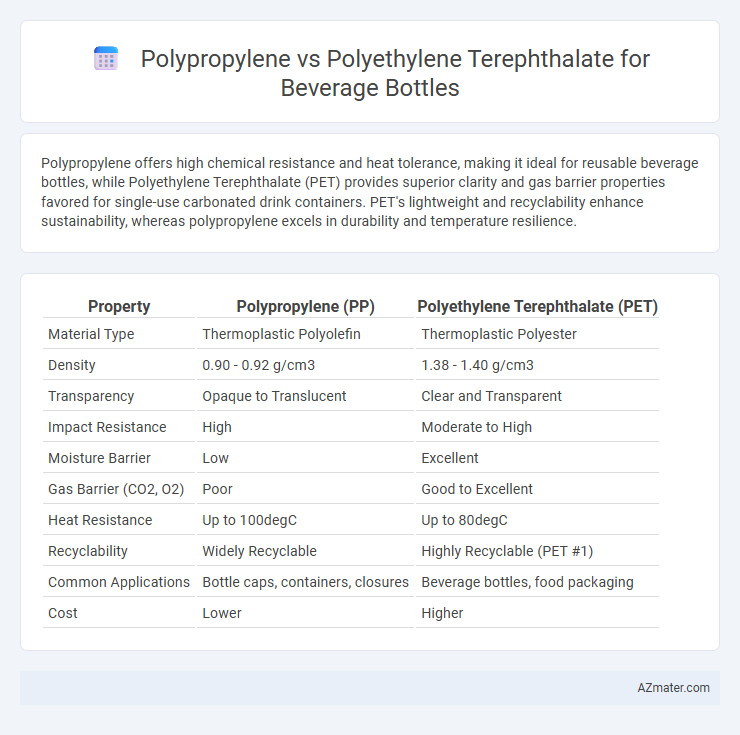Polypropylene offers high chemical resistance and heat tolerance, making it ideal for reusable beverage bottles, while Polyethylene Terephthalate (PET) provides superior clarity and gas barrier properties favored for single-use carbonated drink containers. PET's lightweight and recyclability enhance sustainability, whereas polypropylene excels in durability and temperature resilience.
Table of Comparison
| Property | Polypropylene (PP) | Polyethylene Terephthalate (PET) |
|---|---|---|
| Material Type | Thermoplastic Polyolefin | Thermoplastic Polyester |
| Density | 0.90 - 0.92 g/cm3 | 1.38 - 1.40 g/cm3 |
| Transparency | Opaque to Translucent | Clear and Transparent |
| Impact Resistance | High | Moderate to High |
| Moisture Barrier | Low | Excellent |
| Gas Barrier (CO2, O2) | Poor | Good to Excellent |
| Heat Resistance | Up to 100degC | Up to 80degC |
| Recyclability | Widely Recyclable | Highly Recyclable (PET #1) |
| Common Applications | Bottle caps, containers, closures | Beverage bottles, food packaging |
| Cost | Lower | Higher |
Introduction to Beverage Bottle Materials
Polypropylene (PP) and Polyethylene Terephthalate (PET) are widely used polymers in beverage bottle manufacturing due to their durability and chemical resistance. PET offers excellent clarity, high strength, and superior gas barrier properties, making it ideal for carbonated and non-carbonated beverages. Polypropylene provides greater flexibility and higher melting points, often utilized for caps and containers requiring heat resistance.
Overview of Polypropylene (PP) and Polyethylene Terephthalate (PET)
Polypropylene (PP) is a thermoplastic polymer known for its high chemical resistance, lightweight nature, and excellent fatigue resistance, making it suitable for reusable beverage bottles. Polyethylene Terephthalate (PET) is a polyester with superior clarity, high tensile strength, and excellent gas barrier properties, commonly used for single-use beverage containers. PET offers better moisture and gas barrier performance than PP, enhancing beverage shelf life, while PP excels in impact resistance and temperature tolerance.
Mechanical Properties Comparison: PP vs PET
Polypropylene (PP) offers excellent impact resistance and flexibility but has a lower tensile strength compared to Polyethylene Terephthalate (PET), which exhibits superior stiffness and higher tensile strength, making PET more suitable for maintaining bottle shape under stress. PET's higher thermal resistance and better barrier properties against gases contribute to its preference in carbonated beverage bottles, while PP's toughness and resistance to fatigue make it ideal for squeezable containers. The mechanical properties of PET ensure durability and clarity, whereas PP provides lightweight, cost-effective options with decent mechanical performance for less demanding applications.
Barrier Properties: Oxygen, Moisture, and CO₂ Retention
Polyethylene Terephthalate (PET) exhibits superior barrier properties for beverage bottles, providing excellent resistance to oxygen and moisture permeation, which is critical for maintaining product freshness and extending shelf life. Polypropylene (PP) has comparatively lower oxygen and carbon dioxide barrier capabilities, making it less effective in retaining carbonation and preventing oxidation in beverages. PET's enhanced CO2 retention significantly reduces gas loss, ensuring better preservation of carbonation in carbonated drinks than polypropylene.
Chemical Resistance and Food Safety
Polypropylene (PP) offers excellent chemical resistance against acids, bases, and solvents, making it highly suitable for beverage bottles exposed to various contents, while polyethylene terephthalate (PET) provides robust resistance to alcohols and is less resistant to alkaline substances. Both materials are FDA-approved for food contact applications, but PET is widely preferred for carbonated beverages due to its superior gas barrier properties, which also contributes to maintaining food safety by preventing contamination and preserving freshness. Polypropylene's higher melting point enhances sterilization processes, ensuring stringent hygienic standards without compromising the material's integrity.
Weight and Durability Considerations
Polypropylene (PP) beverage bottles are generally lighter than Polyethylene Terephthalate (PET) bottles, making them preferable for reducing shipping costs and improving portability. PET offers superior durability and higher impact resistance, which enhances its suitability for carbonated beverages by preventing deformation and maintaining bottle integrity under pressure. Weight efficiency of PP contrasts with the toughness and clarity of PET, influencing material selection based on specific beverage packaging requirements.
Sustainability and Recyclability of PP and PET
Polyethylene Terephthalate (PET) offers superior recyclability due to its widespread acceptance in curbside recycling programs and its ability to be turned into high-quality recycled products, including new beverage bottles. Polypropylene (PP) is less commonly recycled but shows potential in sustainability through its lightweight nature and lower carbon footprint during production, contributing to reduced transportation emissions. Both materials face challenges: PET has issues with microplastic pollution while PP's recycling infrastructure needs expansion, making PET currently more sustainable in closed-loop recycling systems for beverage containers.
Cost Analysis for Beverage Bottle Production
Polypropylene (PP) offers lower raw material costs compared to Polyethylene Terephthalate (PET), making PP more economical for large-scale beverage bottle production. PET provides superior barrier properties and clarity but typically incurs higher processing and recycling expenses due to its complex polymer structure. Cost analysis reveals that while PP reduces initial production expenses, PET's enhanced durability and recyclability can lead to long-term savings in supply chain and environmental management for beverage manufacturers.
Applications in the Beverage Industry
Polypropylene offers excellent chemical resistance and high melting point, making it suitable for hot-fill beverage bottles and caps, while polyethylene terephthalate (PET) is preferred for carbonated drinks due to its superior gas barrier properties and clarity. PET's lightweight and recyclability contribute to its dominance in bottled water, soft drinks, and juice packaging. The beverage industry favors PET for enhanced shelf life and visual appeal, whereas polypropylene is selected for specialty applications requiring heat resistance and chemical stability.
Conclusion: Choosing the Right Polymer for Beverage Bottles
Polyethylene Terephthalate (PET) is preferred for beverage bottles due to its superior clarity, excellent gas barrier properties, and recyclability, making it ideal for carbonated drinks and water. Polypropylene (PP) offers higher heat resistance and chemical inertness but lacks the transparency and barrier efficiency needed for most beverage applications. The choice depends on product requirements: PET suits beverage clarity and shelf-life, while PP fits specialized uses needing durability and heat tolerance.

Infographic: Polypropylene vs Polyethylene Terephthalate for Beverage Bottle
 azmater.com
azmater.com